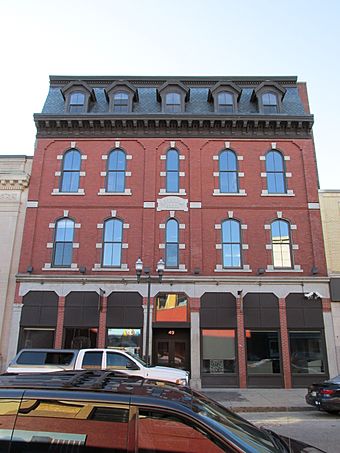Lyceum Hall facts for kids
Quick facts for kids |
|
|
Lyceum Hall
|
|

Lyceum Hall
|
|
| Location | 49 Lisbon Street, Lewiston, Maine |
|---|---|
| Area | less than one acre |
| Built | 1872 |
| Architect | Charles F. Douglas |
| Architectural style | Second Empire |
| MPS | Lewiston Commercial District MRA |
| NRHP reference No. | 86002285 |
| Added to NRHP | April 25, 1986 |
Lyceum Hall is a really old and important building in downtown Lewiston, Maine. It was built way back in 1872. This building shows off the cool Second Empire style of architecture.
It's special because it's one of the few remaining buildings designed by Charles F. Douglas. He was a very important architect in Maine during that time. For many years, Lyceum Hall was the only place in the city where people could go to see shows and performances. Because of its history, it was added to the National Register of Historic Places in 1986.
What Lyceum Hall Looks Like
Lyceum Hall stands on the west side of Lisbon Street. This street is the main shopping area in downtown Lewiston. The building looks like it has three and a half stories. It has a special roof called a mansard roof. This roof style allows for a full fourth floor inside.
The front of the building is very balanced. It has a main section in the middle with one entrance. On either side, there are two matching sections. The main entrance is set back a bit. Above it, on the second and third floors, are narrow, rounded windows.
The ground floor has big glass windows for shops. These are separated by stone or brick columns. The windows on the upper floors have different shapes. Some are rounded, and some have a slightly pointed arch. The roof also has decorative edges and details.
History of Lyceum Hall
Lyceum Hall was built in 1872. It was designed by Charles F. Douglas, a famous architect from the area. Douglas created many buildings in downtown Lewiston after the American Civil War. However, Lyceum Hall is one of the few that still looks mostly the same as it did back then.
When it first opened, the third floor had a huge theater. This theater could hold 1,000 people! It was the only public place for performances in Lewiston for a long time. Later, the city built a Music Hall, which also became a popular venue. Lyceum Hall was fully repaired and made to look new again in the 1980s.



